| Pages:
1
2
3
4
5 |
Nicodem
Super Moderator
      
Posts: 4230
Registered: 28-12-2004
Member Is Offline
Mood: No Mood
|
|
References for the N-oxidation of triacetoneamine:
Tetrahedron Letters, 36(31), (1995) 5519-5522 : Oxone, 82% yield (ref already given upthread)
Journal of the American Chemical Society, 117(42), (1995) 10555-10562 : H2O2, Na2WO4/H2O, 85% yield
Tetrahedron Letters, 29(37), (1988) 4677-4680 : DMDO/acetone, 98% yield
Synthetic Communications, 20(4), (1990) 597-601 : m-chloroperbenzoic acid / Et2O
Chemical Papers, 42(2), (1988) 243-248 : H2O2, 65% yield
Makromolekulare Chemie, 187(11), (1986) 2545-2551 : H2O2, 88% yield
Journal fuer Praktische Chemie (Leipzig), 327(6), (1985) 1011-1014 : H2O2, Na2CO3
Izvestiya Akademii Nauk SSSR, Seriya Khimicheskaya, (2), (1983) 391-394 : 97%
Chemical & Pharmaceutical Bulletin, 28(11), (1980) 3178-3183 : H2O2, 49% yield
EP1595868 : H2O2, NaHCO3, 4h/60°C, 83% yield
GE4432795 : t-BuOOH/ClCH2CH2Cl, 85% yield
US5087752 : DMDO/acetone, 98% yield
WO8705222 : 84% yield
WO2004085397 : AcOOH/AcOH, buffer
…there is a human touch of the cultist “believer” in every theorist that he must struggle against as being
unworthy of the scientist. Some of the greatest men of science have publicly repudiated a theory which earlier they hotly defended. In this lies their
scientific temper, not in the scientific defense of the theory. - Weston La Barre (Ghost Dance, 1972)
Read the The ScienceMadness Guidelines!
|
|
|
guy
National Hazard
   
Posts: 982
Registered: 14-4-2004
Location: California, USA
Member Is Offline
Mood: Catalytic!
|
|
Thanks!
[Edited on 1/30/2007 by guy]
|
|
|
Klute
International Hazard
    
Posts: 1378
Registered: 18-10-2006
Location: France
Member Is Offline
Mood: No Mood
|
|
Triacetoneamine Synthesis
Bringing this thread to life again!
Over 6 months ago, i prepared a bottle to make some triacetoneamine, to oxidize it to 4-keto-TEMPO as a catalyst of benzylic/secondary alcohols
oxydations. Initially, i had planned on leaving it for a couple of weeks, but as time passed i forgot about it, reminding myself to distill it every
now and then...
Being very bored because of my incapacity to manipulate after having wounded my left hand, i couldn't resist anymore and decided on distill the
mixture. Someone gave me a hand (both litteraly and figuratively  ) to put the
distn setups up, and i was off to isolate my 2,2,6,6-tetramethylpiperidin-4-one. ) to put the
distn setups up, and i was off to isolate my 2,2,6,6-tetramethylpiperidin-4-one.
Synthesis of 2,2,6,6-tetramethylpiperidin-4-one (Triacetoneamine)
Condensation
I didn't take notes when i mixed the reagents, so i'm not 100% sure of the numbers. Keep in mind that this reaction wasn't done to obtain good
yield, but just to obtain some product to work with. A lots of improvements can be done, especially during workup, i just wanted to get my product
with the least of efforts, considering my handicap.
In a 500mL bottle, 200mL technical acetone was mixed with 100mL 20% aqeous NH3. Roughly 5g of ammonium chloride and 5g of silicagel were added, and
the bottle was shaken. This was left at room temp for over 6 months, shaking occasionally. The colour change started after a week or two. Strangely,
the colour was more orange than red as in the picture chloric posted [Picture 1], surely because more dilute ammonia was used. A slight
pressure was released a few times. The ammonia smell was less intense as it was as the beggining.
Picture 1

Distillation of the excess reagents
The now fluo (when a light was directed at it) orange mixture was filtered through a cotton plug into a 500mL distn flask. The liquid had a
viscosity comparable to that of cooking oil. A simple disnt setup was attached, with a 15% H2SO4 wash bottle connected to the vacuum inlet. As heating
started, the air present in the system was chased out, at a flow of 1bubble/1-2sec, which increased as ebullition started. Then ammonia gas was
absorbed, as seen but the instant absorbtion of the bubbles and a "cracking" sound. At first, some condensate started passing under 40°C, surely
acetone vapors pushed by the ammonia gas. Then a constant take off started, with vapors temp slowly increasing from 50°C to 75°C. An orange oil
started crashing out as temp increased above 60°C [Picture 2], and some clear organic oil was seen steam distilling (Note 1). At
75°C vapor temp, the flask was cooled, and the top orange oil (Note 2) was seperated in a seperating funnel [Picture 3][Picture
4].
Picture 2
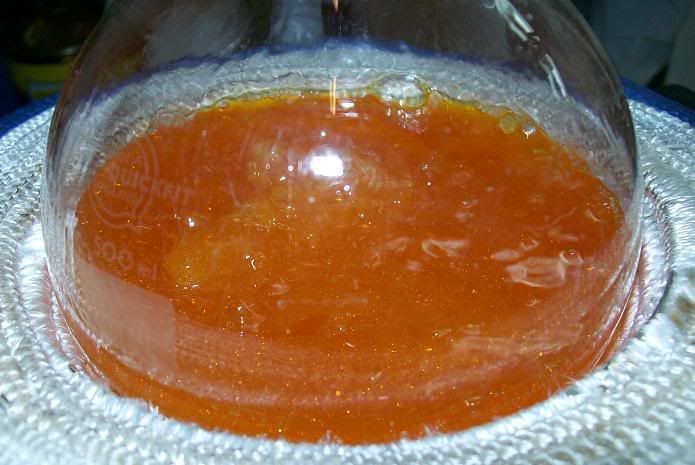
Picture 3

Picture 4

The orangish aq layer was returned to the distn setup, and distn continued until vapors temp increased over 85°C. A very small amount of oil
seperated out. The clear distillate had a small amount of oil, which quickly turned to a white solid (Note 3).
Vacuum fractionnation of the crude oil
The combined organics were directly introduced into a 250mL distn flask [Picture 5], attached a a vacuum fractionnation setup [Picture
6] , using a apirator as vacuum source.
Picture 5
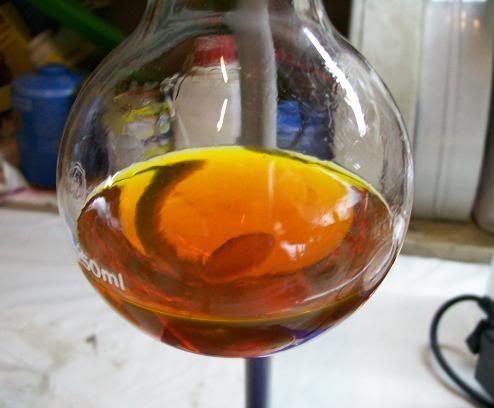
Picture 6

At first some water passed over, with a clear light yellow oil (Note 4). Some white smoke started passing. Vapor temp stabilized at 55°C.
Roughly 20mL of water were collected, with ~5mL of oil floating above. Heating was increased, more smoke was produced, to quite an extent [Picture
7]. Then very strong foaming started, to a point were vacuum couldn't be left on for more than a few seconds before the foam dashed up the
vigreux. The black/brown residu was transfered to the 500mL flask (heavy smoking in air), and distn started again. This time the foaming was well
contained.
Picture 7
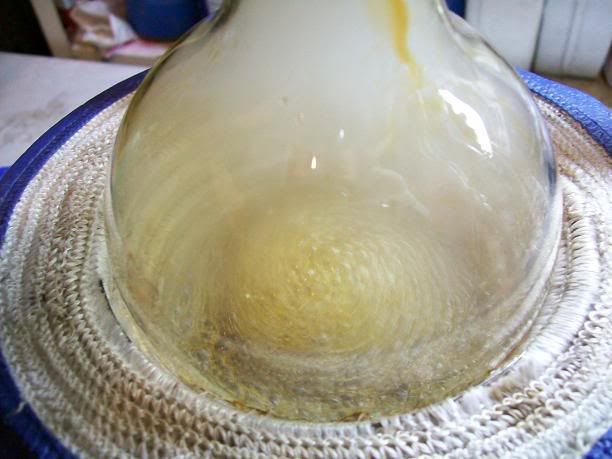
Finally, temp increased, smoking diminished, and a light golden yellow oil started passing over [Picture 8]. A first fraction was collected
(70-95°C) [Picture 9], weighing 10.44g, followed by another one at 95-105°C [Picture 10] weighing 18.5g. The second fraction was
slightly darker. Distn was stopped as head temp increased above 105°C.
Picture 8
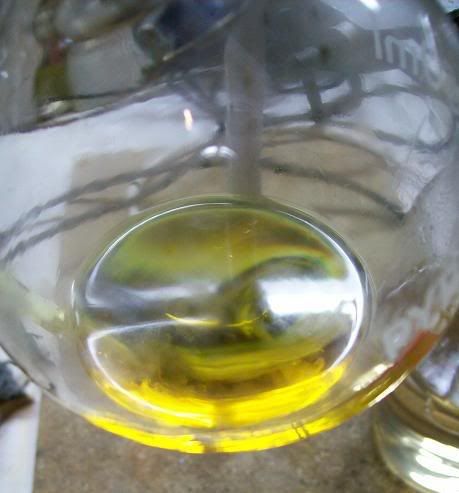
Picture 9
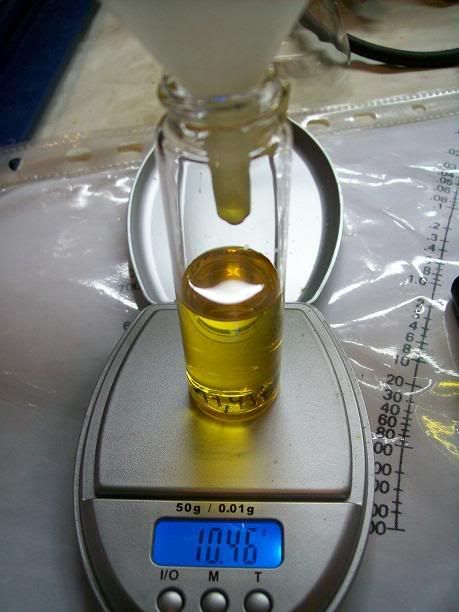
Picture 10

Notes:
Note 1: This was surely the triacetoneamine. This means it could be purified by steam distn if someone is willing to take the time..
Note 2: This oil was pretty viscous, as motor oil, and had a sweetish amine smell, pretty consistant with Guy's description.
Note 3: This is surely the product forming a hydrate with the distd water. I wanted to collect the solid, but when cooling a stupidly
forgot to disconnect the wash bottle, and some H2SO4 was sucked back, dissolving the solid.
Note 4: The large amount of water passing could be du to some uncondensed product cyclizating (sp?) and thus generating water. Or it's
just that the oil can dissolve large amounts of water. Solvant extraction and drying could be more efficient and avoid excessive degradation (smoke).
A few attempt of making a salt were made, adding some H2SO4 in abs EtOH (10% w/v) in the oil dissolved in a little IPA caused some white solids to
appeared but they formed an oily layer after a few seconds. Adding 30% HCl in IPA follwed by acetone didn't produce any cristallization. Any
suggestion regarding salt formation are welcome, as i would like to keep some product as a salt for better stability, because I don't want to oxidize
everything in one go.
To oxidize this amine, i will surely try H2O2/NaHCO3, and perhaps Oxone if the results aren't great. Any advise on this subject are also welcome.
Hopefully, a very efficient oxydation catalyst is at the reach of home chemist. This procedure requires long reaction times, though a few weeks are
surely only needed, but using dry NH3 gas, although more involved, cut reaction times to a few hours (see mentionned patents).
The broad uses and numbers of related publications is very inspiring.
I also want to try reducing the keto- to hydroxy- , to hydroxy-TEMPO, but i'm scared oxidation of the amine would also oxidize the hydroxy group.
But things like acetoxy-, methoxy-, etc could be obtained if a easy way of protecting the secondary amine could be found. Any ideas?
Well, perhaps 4-keto-TEMPO is as efficient as the rest, so why bother.
Once the catalyst is ready, the results of the oxidations will be posted in the benzylic/secondary alcohols oxidations thread.
|
|
|
Nicodem
Super Moderator
      
Posts: 4230
Registered: 28-12-2004
Member Is Offline
Mood: No Mood
|
|
Well, what can I say? Nice work as always, Klute.
Was there a jump in distillation temperature rising between the 70-95°C and 95-105°C fractions? Because otherwise it looks like you have
triacetoneamine in both fractions and maybe you should redistill for a more pure product (if needed pure at all). Also, it is quite possible a lot of
water dissolves in the product or maybe the water distilling out from the crude oil was the consequence of the hydrate dehydrating. That would also
explain the wide distillation interval in spite the distillation column.
The hydrochloride has an mp of 186-190°C (CAS: 33973-59-0). It is actually commercially available and described as "white to slightly beige
crystalline powder".
You should try neutralizing the triacetoneamine solution in isopropanol with conc. HCl, then dry in vacuum and triturate in diethyl ether (the salt
might actually be soluble in acetone).
Triacetoneamine hydrate has an mp of mp 59-61°C. Actually, since the hydrate and hydrochloride are the only commercially available forms, I'm leaning
toward believing that the normal (nonhydrated) form might not be particularly stable. This is also in accordance to my experience. My triacetoneamine
started deteriorating in few weeks (visibly at least).
The tosylate seems to also exist judging from the fact that it has a CAS number (29334-13-2), but I could find no further information.
Edit: Checked the literature and found these other salts exist as well:
nitrate (http://journals.iucr.org/c/issues/2007/04/00/gd3091/index.ht...); thiocyanate, bromide, iodide, perchlorate, and trifluoroacetate (http://dx.doi.org/10.1002/zaac.200500497); sulfate, fumarate, acetate, oxalate, benzoate, picrate… in short, it forms crystaline salts with just
about any proper acid.
[Edited on 6/4/2008 by Nicodem]
…there is a human touch of the cultist “believer” in every theorist that he must struggle against as being
unworthy of the scientist. Some of the greatest men of science have publicly repudiated a theory which earlier they hotly defended. In this lies their
scientific temper, not in the scientific defense of the theory. - Weston La Barre (Ghost Dance, 1972)
Read the The ScienceMadness Guidelines!
|
|
|
Klute
International Hazard
    
Posts: 1378
Registered: 18-10-2006
Location: France
Member Is Offline
Mood: No Mood
|
|
Thank you, Nicodem. I couldn't have done it without all the ref you provided...
Yes, the freebase seem quite sensible, it has darkened to an orange color overnight! The entire 2nd fraction was subjected to oxidation.
The first fraction justr steadily increased in temperature, i think it is quite pure TAA, just that the smoke entrained the vapors, so the
temperature wasn't that of the refluxing vapors... It might contain a bit more impurites than the second though. I will try to crystallize and
recrystallize it with aq HCl and IPA as you propose. I'm not too confortable with the acetone/H2SO4 technic mentionned in one of the patents. If it
doesn't crystallize out, removing the acetone will surely creat more by-products.
Except for the steam distilled residu, i haven't seen any of the distilled oil form a hydrate, at least not immediatly. I tried adding a drop of
water to a mL of TAA just before the oxydation, they simply formed a homogenous yellow solution. I guess it needs to be done in the cold and in more
time.
Oxydation of 2,2,6,6-tetramethylpiperidin-4-one (Triacetoneamine) to 4-Oxo-2,2,6,6-tetramethylpiperidine-N-oxyl (4-oxo-TEMPO) with alkaline
H2O2
The procedure from US 0256312A1 given above was followed, using AcONa as cocatalyst. The workup was inspired by WO8705222.
All the used glassware was washed with distilled water to avoid contamination with metal salts.
18.5g (119.18 mmol) of distilled 2,2,6,6-tetramethylpiperidin-4-one (Note 1) were placed in a 100mL 3-neck RBF with a stir bar[Picture
1]. 5mL of water were used to rinse the container. This formed a homogeneous orange solution.
Picture 1
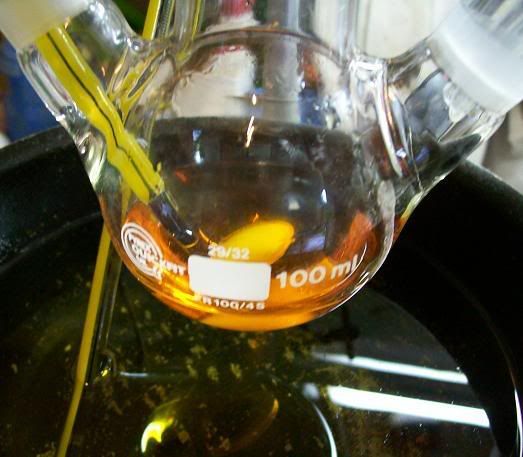
In a seperate container, 1.05g (12,5mmol; 0.95eq) of NaHCO3 were covered with 5mL of water, and 0.2g (3.33mmol; 0.27eq to the NaHCO3) of acetic acid
were added dropwise, with stirring (CO2 evolution). The erlenmeyer was slightly heated to dissolve the NaHCO3. This solution was added to the RBF,
giving two layers [Picture 2], and heated in a oil bath to 60°C.
Picture 2

17.93mL (208.57 mmol); 1.75eq to the TAA) of 35% H2O2 were then added dropwise over 3h, keeping the temperature between 55 and 65°C. The orange
color gradually turned dark red over the first hour [Picture 3], and darkened further [Picture 4]. At the end of the addition,
stirring was continued for another hour at 60°C [Picture 5].
Picture 3
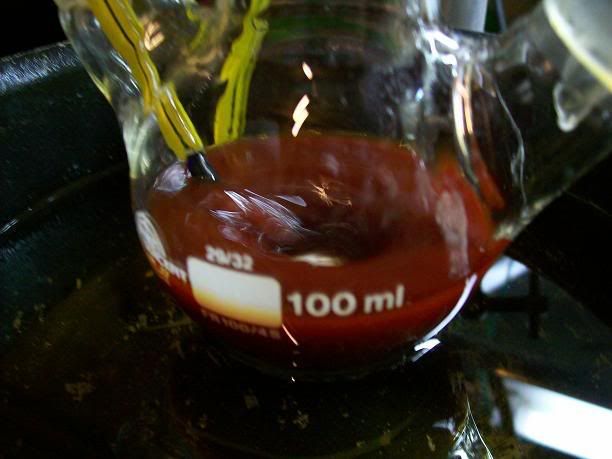
Picture 4

Picture 5
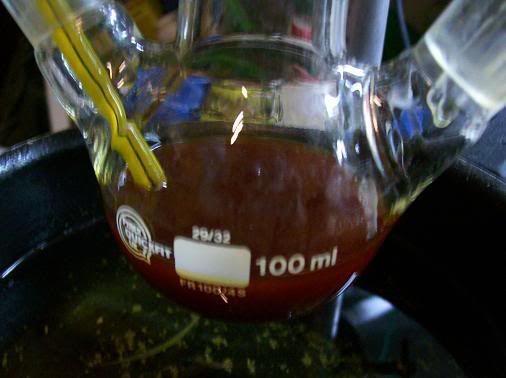
The flask was cooled to room temp, and 10mL of water was added to the dark red emulsion, followed by 25mL DCM. pH was brought to 2 with 10% HCl (very
slight bubbling), and the two layers seperated. The orange aqueous was extracted with 3*10mL DCM. The combined extracts were washed with 50mL water
Picture 6, and 50mL brine Picture 7, before been dried over Na2SO4 and placed in the freezer.
The solvent will be removed tomorow.
Picture 6

Picture 7
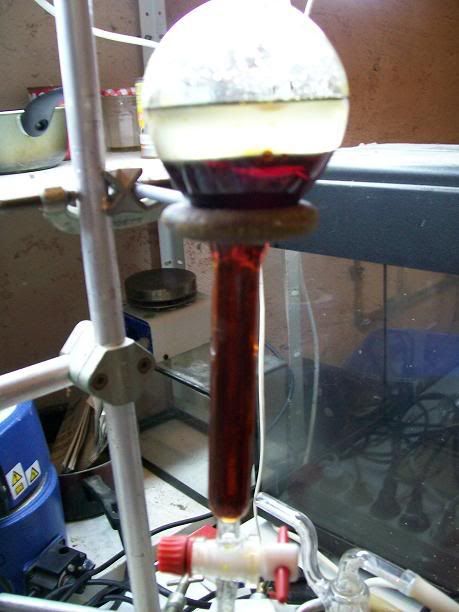
Final extract

Notes:
Note 1 : The initially clear yellow freebase had turned orange when kept over night at room temp.
Comments
This reaction is very smooth and easy to perform. I'm sure the H2O2 addition can be done more quickly (they add it over 4h in the patent). The
demethydioxirane oxidation looks very interesting by the very short reaction time and easy workup, but preparing pur DMD in acetone is tedious. I'm
sure adding oxone to acetone and using the suspension directly could work out nicely, filtering before evaporating the solvent.
I'm not too sure how to purify the product, i don't want to do a coluum, being out of chromatographic silica. Apparently the mp is pretty low
(~30°C), so recrystallization would be tedious. Any ideas?
Can't wait to try the oxidations out! Even though i have too 
[Edited on 6-4-2008 by Klute]
|
|
|
guy
National Hazard
   
Posts: 982
Registered: 14-4-2004
Location: California, USA
Member Is Offline
Mood: Catalytic!
|
|
Wow Klute. I want to try this reaction again. VERY Nice work.
If you want TEMPO, you should try a Wolf-Kishner reduction on your triacetone amine first.
[Edited on 4/5/2008 by guy]
Also, try adding hexanes to your oil and see if solids crystallize out. Ive done stuff in the lab where I get an oil but if I add hexanes, it crashes
out.
[Edited on 4/5/2008 by guy]
Here is an IR spectrum from Aldrich in case you wanted to confirm (4-oxo-TEMPO)
http://www.sigmaaldrich.com/spectra/ftir/FTIR001993.PDF
[Edited on 4/5/2008 by guy]
[Edited on 4/5/2008 by guy]
|
|
|
Klute
International Hazard
    
Posts: 1378
Registered: 18-10-2006
Location: France
Member Is Offline
Mood: No Mood
|
|
Thanks alot of the spectrum. I will compare when i can.
I don't think i would want to try a wolf kishner on it, needing hydrazine and all, i'm pretty sure it will be as efficient as tempo. In any case, a
NaBH4 reduction would give 4-hydroxy-TEMPO, often mentionned in patents/articles.
I would definatively encourage you to try it again! Let the 4-oxo-TEMPO spread 
|
|
|
not_important
International Hazard
    
Posts: 3873
Registered: 21-7-2006
Member Is Offline
Mood: No Mood
|
|
For a reduction you might do something similar to this:
http://www.orgsyn.org/orgsyn/prep.asp?prep=cv6p0289
having a free amine group might lead to problems and polymeric goop, though. Running it in Ac2O should get around that, but Ac2O is a problem in
itself.
|
|
|
Klute
International Hazard
    
Posts: 1378
Registered: 18-10-2006
Location: France
Member Is Offline
Mood: No Mood
|
|
I would rather use NaBH4, as it seems to be a prety easy reduction; in one of the above patents, they obtain the hydroxy derivative with NaBH4. I
guess reduction in methanol is all it takes.
But for alkylating/acylating the hydroxy group without touching the amine, i have no idea. At first, i was thinking of oxydizing the hydroxy
derivative to the nitrosyl, and then alkylating with NaH/Mei or EtBr, but i guess the nitrosyl will be affected by those conditions.
How about forming the 4-oxo tosylate, reducing the C=O with NaBH4, alkylating the hydroxy, and basic hydrolysis of the sulfoamide before oxydation?
I'm not too sure of the conditions to hydrolyse such a sulfoamide.
In the same way, other alkoxy- and acetoxy- (with Ac2O, I have enough at hand to make a with trials) could be obtained.
It would be nice to compare the efficienty of each catalyst towards oxydation. I think i will be using TCCA as co-oxidant, as it is more stable than
NaOCl and would help getting reproducible results. There alot of different reaction conditions appliable here (two-phase, PTC or not for
electro-donating cycles, one phase, PTC or not, etc etc) with either TCCA and other chloramines, hypochlorites, etc
Things would surely go much quicker if several people tried this out  The
4-oxo-TEMPO qsynthesis can take a weekend's work at most if using NH3 gas, or a afternoon if mixing aq ammonia and acetone and forgetting it for a few
weeks, counting the distn and oxidation. I means, how much more available can it get? Ammonia and acetone The
4-oxo-TEMPO qsynthesis can take a weekend's work at most if using NH3 gas, or a afternoon if mixing aq ammonia and acetone and forgetting it for a few
weeks, counting the distn and oxidation. I means, how much more available can it get? Ammonia and acetone  ! !
EDIT: Sorry notimportant, i thought you were talking of the reduction to the hydroxy compound.. As soon as i saw non-amalgamated zinc, i thought of a
simple reduction... I might try it out when i do more triacetoneamine. I'm sure it's (TAA) synthesis can be greatly improved..
[Edited on 6-4-2008 by Klute]
|
|
|
Nicodem
Super Moderator
      
Posts: 4230
Registered: 28-12-2004
Member Is Offline
Mood: No Mood
|
|
I doubt the Org. Synth. modification of the Clemmensen reduction works on such substrates, if nothing else I doubt the triacetoneamine hydrochloride
is soluble enough in any such aprotic nonpolar solvent system.
For the O-acetyl derivative, I think you could easily prepare it if you make the hydrochloride of 4-hydroxy-2,2,6,6-tetramethylpiperidine and just let
it stir in excess acetic anhydride for a while (some heating to ~50°C might be needed). There should be no N-acetylation occurring since
N-protonation is generally protection enough.
The O-methylation would best be done on dry 4-hydroxy-2,2,6,6-tetramethylpiperidine base in THF by O-deprotonation with NaH followed by MeI addition
at room temperature. There might be some N-methylated side products, but probably irrelevantly little since the nitrogen is sterically hindered. You
might be more interested in O-benzylation since this would allow you to follow the alkylation and the N-oxidation reaction by TLC (you would have UV
absorbing products).
I would not consider the O-acetylation and O-alkylations of 4-OH-TEMPO since it is a free radical after all and its chemistry might not be so easy.
But first try some alcohol oxidations with plain 4-oxo-TEMPO since I believe in most cases it is similarly effective as TEMPO itself.
…there is a human touch of the cultist “believer” in every theorist that he must struggle against as being
unworthy of the scientist. Some of the greatest men of science have publicly repudiated a theory which earlier they hotly defended. In this lies their
scientific temper, not in the scientific defense of the theory. - Weston La Barre (Ghost Dance, 1972)
Read the The ScienceMadness Guidelines!
|
|
|
Klute
International Hazard
    
Posts: 1378
Registered: 18-10-2006
Location: France
Member Is Offline
Mood: No Mood
|
|
It's good to the the acylation can be performed easily. Any acetamide could be easily seperated with a A/B extraction. I could try direct comparaison
of the oxo- and acetoxy- catalyst before trying other modifications.
Concerning the oxydations, I'm still hesitating as to the reaction conditions to use. I'm leaning towards using TCCA as primary oxidant as NaOCl
solution will have to be titrated or freshly prepared to get any reproducible results. I think DCM 2-phases or with a few drops of water in the cold
will be tried first, with 20-50mmol batch of benzyl alcohol. When i get good results, i will try substitued alcohols.
Apparently, electron-donating substituants gives lower yield with 2 phase NaOCl oxidations, so some optmization might be needed with such
substituants.
I haven't found any ref with benzoxy-TEMPO used as catalyst, but it could be worth a try latter on. I would like to find a way of protecting the
amine though.
|
|
|
Klute
International Hazard
    
Posts: 1378
Registered: 18-10-2006
Location: France
Member Is Offline
Mood: No Mood
|
|
After removal of the solvant, 19.4g of a dark brown/black oil is obtained.
TLC (DCM) of the TAA (first, less pur fraction) reveals at least 3 impurities. I am unable to locate the TAA spot...
The oxidation extract shows that most of the stains haven't changed, only the largest one present in the TAA is much smaller, and one above is
slightly bigger. I'm not sure if the nitrosyl can be revealed under UV lamp, though i can't find a reason why it would not . There also is a
none-eluted brown spot.
I figured out i shouldn't have acidified with HCl, as apparently at low pH (<2) the TEMPO nitrosyl can disproportionate to a hydroxylamine and a
nitrosonium salt. But i didn't add too much acid, and the fact that i recovered 19.4g product means there wasn't much left in the aq layer.
I will try a alcohol oxidation with the crude product i obtained, and one without to compare. Or beging the oxidation without the catalyst, monitering
by TLC, and then add it and see how things change.
I would like to find a way of purifying the TAA, i don't think a A/B could be used here considering how soluble the freebase is in water. Forming a
salt isn't easy, i haven't tried Nicodem's proposition yet, but adding dry H2SO4 in EtOH to the amine in either IPA or acetone, or conc HCl to the
amine in IPA followed by pet ether (which usually works well) only gave a oil or noting at all, even after freezing.
BTW, the first, less pur fraction of the freebase doesn't solidify in the freezer. I think gassing dry NH3 in acetone could give a cleaner product.
Alot of side reactions could have happened during 6 months. Also, the tubing that i use to connect the aspirator to the disnt setup finished BLACK
from all the smoke that passed through.
EDIT: I haven't been able to do a IR spectrum on it, and won't be able to do so for another 2 weeks, so i will surely try the oxidations before.
[Edited on 12-4-2008 by Klute]
|
|
|
LSD25
Hazard to Others
  
Posts: 239
Registered: 29-11-2007
Member Is Offline
Mood: Psychotic (Who said that? I know you're there...)
|
|
Klute, I've said it before and I'll say it again, your glassware makes me jealous
So, you suggest adding dry ammonia gas to acetone? Ok, how much ammonia am I adding to how much acetone? How well does acetone hold ammonia?
By the way, this article might be on topic if anyone has access (I'd ask in the right place, but I cannot get there to do so):
I have also attached an article retrieved by Solo on the Wolff-Kishner on triacetoneamine to tempo on a rather large scale.
Attachment: W-K.Redn.TAA.to.TEMPO.pdf (99kB)
This file has been downloaded 3224 times
Whhhoooppps, that sure didn't work
|
|
|
Klute
International Hazard
    
Posts: 1378
Registered: 18-10-2006
Location: France
Member Is Offline
Mood: No Mood
|
|
Thanks for the articles! I'm requesting the first one right now.
Concerning the wolf-kishner, i can't perform such a reaction as i haven't got any hydrazine, and don't want to acquire some (toxicity). On the
second hand, i'm convinced 4-oxo-TEMPO and 4-hydroxy-TEMPO can lead to catalysts as efficient as TEMPO itself. They can be modified in a large number
of ways (reductive amination, alkylation, acylation, etc). I'm sure we could get some nice @SM publications out of these, rather than walking on the
paths of all the chemist that have been using TEMPO for the last decade... 
The procedure using dry NH3 gas is detailed in one of the patents given in this thread. You will find all the information needed there.
I plan on trying it out also, as i'm not satisfied by the purity of the product i isolated. I will post details when i get to perform the reaction.
Please share your results if you try the reaction!
EDIT: Concerning the glassware, i've damadged 10 of those red screw rings you can see at each joint, left them in the base bath for too long (couldn't
get them out myself because of my hand), by the time someone was kind enough to get them out (not a nice task i admit), the more than 1-2mm of plastic
had been eaten ! I'm not sure what kind of plastic it is, but when adding acid to the rinsing water, fluffy white amorphous solid appeared.... there
some of this plastifiant in the base bath too, but if the glassware is directly rinced without adding any acid, it doesn't cause any problem... I
guess it some kind of acid monomer (as terephtalic acid or something...). Going to have to buyt some more.Hopefully the teflon joints are not harmed.
I guess it made me mearn a lesson: always take them off before puttingthe glassware in the base bath! Usually they handle a few days no problem,
though i try to never leave the glassware in for more than 24h.
EDIT 2:
Sparky very kindly retreived the above article on TAA synthesis. They gas dry NH3 into acetone/CaCl2, at room temp or just under reflux, but do so
over 3-4 days! The whole reaction takes a week, counting a few days of stirring after introduction of the NH3. I might try doing it over a shorter
period, perhaps 2 days, as they claim no more than 1/4 of the total NH3 could be gassed in during the first day. They claim the crude product has a
85% purity, and that distn affords a product of ~95% purity, which would be more than enough for the oxidation.
Actually, i think i would rather try the procedure followed in US3,959,295, where a suspension of NH4Cl in acetone is gassed with NH3 over 12H at
~15°C, then more acetone is added and reflux maintained for 12H. The way they isolate the hydrate seems very interesting, provided it works.
[Edited on 14-4-2008 by Klute]
|
|
|
LSD25
Hazard to Others
  
Posts: 239
Registered: 29-11-2007
Member Is Offline
Mood: Psychotic (Who said that? I know you're there...)
|
|
I am currently trying this reaction with OTC acetone which has been gassed with ammonia in the presence of CaCl2 (I know it seems kinda odd, but have
a look online - it seems to be well supported, so we'll see) kinda similarly to the idea in this paper (although I only have access to the front page:
http://pubs.acs.org/cgi-bin/abstract.cgi/jmcmar/1963/6/i04/f...
It has been in the cupboard for about a week and all I can see is a clear liquid with some undissolved CaCl2 and a fine, fluffy precipate (also
whitish - although it doesn't look completely white). I do however know that the characteristic acetone smell has changed (I cannot smell either it or
ammonia but a sharper smell which is kinda hard to describe). I didn't make any effort to dry either the acetone or the ammonia (it seemed kinda dumb
in light of what I was using as a catalyst) so the reaction should (going on previous experience) be a long way from anhydrous. I'll report back again
in a week or two.
Whhhoooppps, that sure didn't work
|
|
|
Klute
International Hazard
    
Posts: 1378
Registered: 18-10-2006
Location: France
Member Is Offline
Mood: No Mood
|
|
Nice Alice! Good to see other people trying this out! I have put the project aside for the moment, I realized my TAA wasn't more than 50% pur when i
isolated the hydrochloride salt.. I want to try gassing over one or two days and distn straight after.
In my first try, it took at least two weeks before the color change was significant, so i wouldn't be worried..
Keep us updated!
\"You can battle with a demon, you can embrace a demon; what the hell can you do with a fucking spiritual computer?\"
-Alice Parr
|
|
|
LSD25
Hazard to Others
  
Posts: 239
Registered: 29-11-2007
Member Is Offline
Mood: Psychotic (Who said that? I know you're there...)
|
|
I actually just looked and while the quantity of the precipate has increased markedly, there has also been a marked colour change to a dull,
pale-yellowish hue.
Whhhoooppps, that sure didn't work
|
|
|
LSD25
Hazard to Others
  
Posts: 239
Registered: 29-11-2007
Member Is Offline
Mood: Psychotic (Who said that? I know you're there...)
|
|
Looked in again, the liquid is now a definate clear-yellow type colour - the smell is odd as, a sort of acetone mixed with urine type odour, although
the acetone aspect is merely colouring the other smell. I think the absence of water (well the CaCl2 must be doing something, right?) seems to be
making this work nicely - there is only the slightest tinge of orange. I'll leave it another week then fractionate it (actually, Klute - you think
steam distillation might work better?).
[EDIT]
Just went to add more NH3 - must have mistreated my shit-glass (the stuff I use for gas generation - has a wheel on it) - it cracked and sent
caustic/MAP sludge everywhere - when I tried to do what I could to prevent spillage I noticed some water/NaOH going into the bottle this was in - the
yellow colour was dimmed fairly rapidly, the solution is cloudy - but I have enough cleaning up to do now, I'll just chuck it in the cupboard and see
how it looks (I really should start over, but yeah ). ).
[Edit No.2 - attached crap photo of filtered liquid (my camera is fucking up, time to get a new one)]
[Edited on 10-5-2008 by LSD25]
[Edited on 10-5-2008 by LSD25]
[Edited on 10-5-2008 by LSD25]
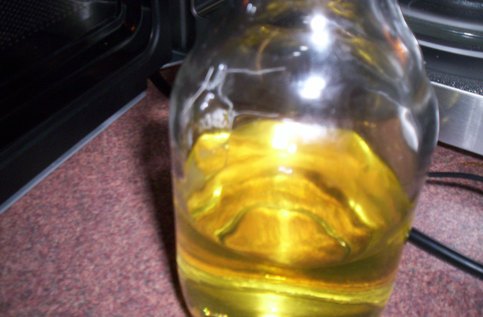
Whhhoooppps, that sure didn't work
|
|
|
Klute
International Hazard
    
Posts: 1378
Registered: 18-10-2006
Location: France
Member Is Offline
Mood: No Mood
|
|
You could try working it up now; in one patent and the "improved synthesis" article, they work up 48h after gassing. One way of extracting it is to
add NaOH solution, seperate the oil, and extract the aqueous. Remove your solvent and fractionnate.
I'm not sure if some add water would be good for the reaction, and the NaOH could cause over-condensationn products.
Keep us updated!
\"You can battle with a demon, you can embrace a demon; what the hell can you do with a fucking spiritual computer?\"
-Alice Parr
|
|
|
LSD25
Hazard to Others
  
Posts: 239
Registered: 29-11-2007
Member Is Offline
Mood: Psychotic (Who said that? I know you're there...)
|
|
Hang on a minute - the CaCl2 should have at least dried the acetone, right?
Now I want to extract an amine from dry acetone?
What is the solubility of the HCl salt in acetone?
[EDIT]
Not fucking much by the look of things - I just set up a HCl gas gen (CaCl2 + HCl + heat + drying train) - then gassed 1/2 the yellow liquid remaining
(I diluted it with additional dry acetone).
As seen in the photo - a reddish-grey, seriously cloudy solution resulted - I'll let this settle overnight and then filter off the solvent in the
morning
[Edited on 10-5-2008 by LSD25]
Sorry Nicodem, I just now re-read this page - I guess that is what you were hinting at further up the page, huh?
[Edited on 10-5-2008 by LSD25]
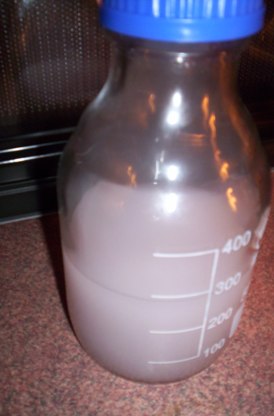
Whhhoooppps, that sure didn't work
|
|
|
LSD25
Hazard to Others
  
Posts: 239
Registered: 29-11-2007
Member Is Offline
Mood: Psychotic (Who said that? I know you're there...)
|
|
I aded in the other half of the TAA (Triacetone Amine) and gassed it - unfortunately it was mother's day here yesterday and obvious family commitments
took up rather a lot more time than I had anticipated.
Thus the light-pinkish grey liquid was left for a day - now there are two things to report here, the growth of a cloudy, crystaline layer in the
bottle (and a pinkish crystaline layer in the bottom of the bottle) which says to me that the TAA is at least slightly soluble in Acetone.
I took it and carefully (no need as you will see) decanted the pinkish-reddish clear liquid off the crystal layer, which did not move then heated it
carefully in a simple distillation setup. A small amount of excess HCl (g) came over first then the pot rapidly heated to about 56C and then stayed
there for the first 5/6 of the distillation. A small amount of high-boiling tar appeared as did a rather large amount of crystals (especially in the
last 100mL of the distillation). The distillate to this point has come over exclusively between 56-58C and is a clear, volatile liquid with a
distinctive odour (rather different to the odour of the crap I put in the pot in fact).
Anyone got any idea what these crystals are able to be washed in? They are well and truly soluble in water, so I was thinking that I'd separate from
the oily-tar layer in a sep. funnel and then dry - recrystalize from EtOH/EtOAc? The yields are crud on this scale, I think that I should have added
2-3 more lots of ammonia, but given the fuckup detailed above, working up was about all that could be done.
[EDIT] I am going to have to try that one again - I think I might have to attempt something else - the oily crap has one hell of a pong which is why
it was ditched (when diluted with water the oily stuff solidifies into polymeric crap which is kinda soapy), unfortunately I tried extracting without
filtration cos I'm daft - the oily shit then dissolved and stunk out every single attempt to do anything thereafter (it appears to exist equally in
both the polar & non-polar layers and it bumps badly when you heat both, even with chips).
Unfortunately without boiling the shit dry it appears to be virtually impossible to rid it of some remnant of acetone. I think I might just boil the
next lot dry and we'll see if the crap can be removed. Of course, if the gassed (HCl) liquid was extracted promptly, then I suspect the problem would
be much lighter duty.
Fuck it - I think it might be easier to go the fractional distillation route.
[Edited on 11-5-2008 by LSD25]
Whhhoooppps, that sure didn't work
|
|
|
LSD25
Hazard to Others
  
Posts: 239
Registered: 29-11-2007
Member Is Offline
Mood: Psychotic (Who said that? I know you're there...)
|
|
Right, the recovered acetone was gassed again, in this instance three times. Gassing was continued in each case until a white precipate was formed
when additional ammonia gas was introduced and a correspondent large amount of white smoke was formed when any bubbles made it to the top of the
liquid (if done carefully, rarely will bubbles ever make it to the top). The white precipate I am assuming appears to be a complex between whatever
dissolved CaCl2-H2O was present in the acetone and its subsequent reaction with excess ammonia (some H2O is generated in the amination is it not? I
know some was there to start with).
This has been done on each of the last four days, immediately after the gassing of the clear, light yellow, yellow, dark yellow* (day 1, day 2, day 3
and today) liquid was stirred at med-high speed for one hour.
*Klute - the liquid is beginning to look a whole lot like your distillate, but until I get the money to spring for some TLC plates, it is hard to
know. Workup will probably take place tomorrow - I'll gas it one more time first.
Whhhoooppps, that sure didn't work
|
|
|
Klute
International Hazard
    
Posts: 1378
Registered: 18-10-2006
Location: France
Member Is Offline
Mood: No Mood
|
|
Pet ether works great for washing the TAA.HCl. I recrysatllized it with IPA/Pet ether, or even IPA/Acetone, finishing in the freezer.
In one of the patents on the first or second page, they directly add either conc. H2SO4 or dry HCl gas to isolate the amine from the reaction
medium. You need to do it in the cold though, to avoid excessive aldol condensations and leave it to stir/sit for a few hours to complete cristn.
I will trying out the reaction again in a month or so, so we can compare how things go when using different procedures/proportions. It always much
more appreciable to be several working on the same project 
\"You can battle with a demon, you can embrace a demon; what the hell can you do with a fucking spiritual computer?\"
-Alice Parr
|
|
|
LSD25
Hazard to Others
  
Posts: 239
Registered: 29-11-2007
Member Is Offline
Mood: Psychotic (Who said that? I know you're there...)
|
|
I have just spent 2 1/2 hours gassing the crap out of the yellow liquid while it was still cold - there was no colour change or anything else. When
placed back in the freezer all that happened was the constant evolution of HCl gas, there is no change in the appearance of the solution. I added some
additional dry acetone and gassed again - nothing (more HCl(g) evolved when cooled - obviously solubility related). Obviously the salt is highly
soluble in acetone (I'd say the lack of solubility in the non-cooled solution may be related to the solubility of the salt in the mixture of acetone
and the aldol condensation products).
Anyone got any suggestions?
[Edit]
Sorry to recant - slight, ultra-fine crystals are apparent (only when mixture is agitated and can only be viewed against strong backlighting) in the
yellow solution. Hmmm, I think more time will allow these to come out - oh yeah, I just scratched fuck out of the sides with an old stir-rod, these
suckers are sorta reticent but they've started.
[Edited on 15-5-2008 by LSD25]
[Edit 2]
I lost patience and simply boiled off the acetone - the yields are crap - seems a lot of the amine didn't come into contact with the HCl (had to boil
off the yellow oil 'cos I wasn't prepared to fuck around this time around ). In the
end I got a minute yield of a beige salt, with a small amount of black tar. Unfortunately the 'PYREX' (supposedly) baking dish decided to emit a wee
crack and then turn into shrapnel. I collected as much as I could, then started extracting that with 95(ish)% EtOH - the black tar is not seeming to
come through the large funnel, while the salt is dissolving and turning the resultant solution yellow as I write. I'll pour the filtrate back over the
shattered glass a couple more times and then discard the glass. I'll then remove the EtOH and see how I go (I'll simply reduce it as much as I can via
distillation, then crystallise). ). In the
end I got a minute yield of a beige salt, with a small amount of black tar. Unfortunately the 'PYREX' (supposedly) baking dish decided to emit a wee
crack and then turn into shrapnel. I collected as much as I could, then started extracting that with 95(ish)% EtOH - the black tar is not seeming to
come through the large funnel, while the salt is dissolving and turning the resultant solution yellow as I write. I'll pour the filtrate back over the
shattered glass a couple more times and then discard the glass. I'll then remove the EtOH and see how I go (I'll simply reduce it as much as I can via
distillation, then crystallise).
[Edited on 16-5-2008 by LSD25]
Whhhoooppps, that sure didn't work
|
|
|
Klute
International Hazard
    
Posts: 1378
Registered: 18-10-2006
Location: France
Member Is Offline
Mood: No Mood
|
|
To crysatllize my oil, I proceeded as Nicodem advised me to: I diluted the oil with some IPA, neutralized with conc. HCl, then distilled 2/3 of the
IPA off, until the BP increased over that of the azeotrope. I then left it to cool, at ~40°C I slowly added ~10mL of pet ether as one layer (on the
sides of the flask), and left evrythign over night. A tane/pinkish powder had appeared the next moring, covered with a little tar. I vac. filtered it,
washed with cold acetone, which remove dthe tar evry well without dissolving the powder (visibly) then washed with pet ether, and dried by suction for
10min.
The very bad yield confirm that the oil I collected wasn't more than 30% TAA, which i feared after seeing the composition by TLC. That's why I had
hope the short method with dry NH3 gas would lead to a much more purer product. If that isn't the case, we will just need to do this big scame to
obtain a decent amount of product to work with. The oxidation seem clean enough if done with a clean product, whan iwill try this I will purify the
4-oxo-TEMPO via coluum the first time, and see how the pur the crude product is. I'm pretty sure it will be possibly to use the crude product as is,
but at least there will be a pur sample to compare to. ALso, whenni have the possibility, I will run an IR on the crude and pur product, and compare
with the spectrum Guy kindly provided....
Why don't you try removing most of the acetone after decanting from the CaCl2, then adding dilute NaOH, seperating the oil and cristallizing it with
IPA/HCl? I know it's longer work...
Or maybe try with conc. H2So4, possibly the sulfate is less soluble in acetone than the hydrochloride, or the salt forms easier..
Don't disesper Alice, I'll soon join you again!
\"You can battle with a demon, you can embrace a demon; what the hell can you do with a fucking spiritual computer?\"
-Alice Parr
|
|
|
| Pages:
1
2
3
4
5 |
|